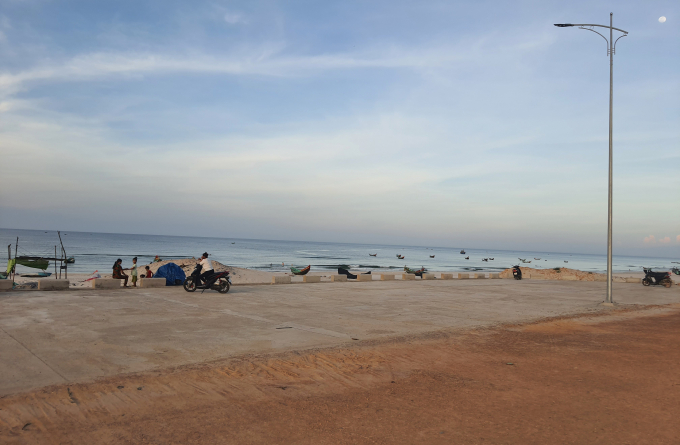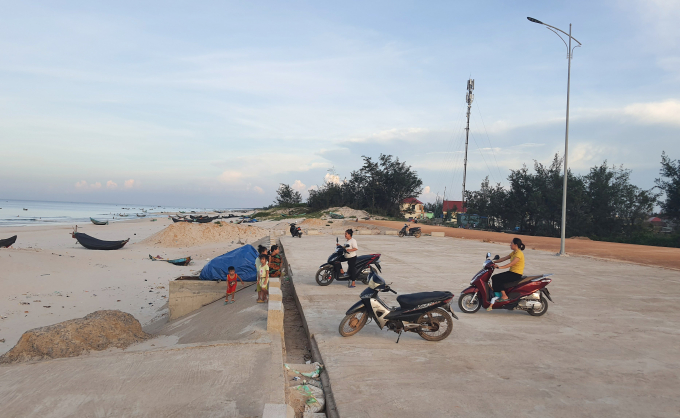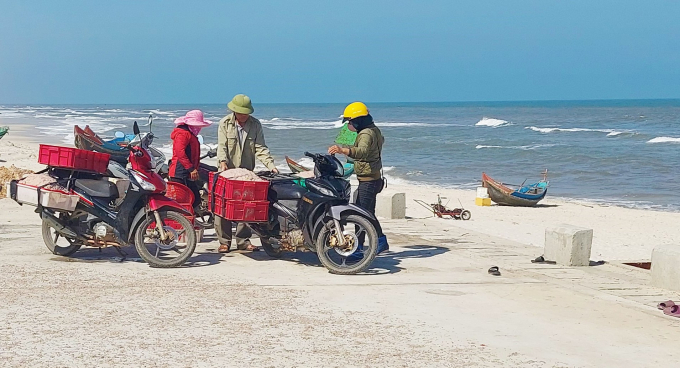November 26, 2025 | 19:54 GMT +7
November 26, 2025 | 19:54 GMT +7
Hotline: 0913.378.918
November 26, 2025 | 19:54 GMT +7
Hotline: 0913.378.918

A new fishing wharf has been invested in Hai Ninh commune, creating favorable conditions for fishermen to stick to the sea. Photo: T.P.
As a horizontal area, where rivers and canals cut and surround, the two districts of Quang Ninh and Le Thuy, Quang Binh province, face difficulties in natural conditions in socio-economic development. The local authorities and people are also concerned when ships are docked after long sea fishing trips.
Quang Binh province currently has nearly 4,000 boats, but mainly anchors and unloads goods at grade 3 fishing wharves, even negligible, spontaneous fishing wharves. The cost of sea trips, which has increased by gasoline and input materials, is further increased due to narrow berths and limited cargo capacity.
To develop fisheries infrastructure, Quang Binh has mobilized and integrated many capital sources to build more fishing wharves in the flat sea, creating favorable conditions for fishermen in this poor sea.
“The province has mobilized many capital sources to invest nearly VND 100 billion in building fishing wharves in communes with flat seas. That is a precondition for fishermen to develop fishing and seafood processing”. Mr. Le Van Loi, Deputy Director of Quang Binh Department of Agriculture and Rural Development, said.
Starting from 2021, Quang Binh province combines infrastructure development, roads with fisheries logistics services such as storm shelters for boats; shipbuilding and repairing establishments; stations providing raw materials, fuel (petroleum, ice...), fishing gear, and equipment for fishing; seafood outlets…

A new fishing wharf has been newly invested in Ngu Thuy commune. Photo: T.P.
Le Thuy and Quang Ninh districts are now more and more spacious. Each fishing wharf is about 120m long and 20m wide, with reinforced concrete sand retaining walls and access to the beach. Large trucks can conveniently go up and down the wharf to transwharf seafood.
Mr. Nguyen Huu Han, Vice Chairman of the Le Thuy District People's Committee, said that communes with flat seas had received investment capital to build 15 fishing wharves and 23 roads.
With a total length of nearly 10km, connecting the village's main road to the fishing wharves in two communes, Ngu Thuy and Ngu Thuy Bac, the constructions are now being put into use and promoting good efficiency.
"We have made efforts to create momentum for fishermen to ensure their livelihood, from fishing and processing to seafood trading," said Mr. Han.
The wide road connecting the inter-commune route of Ngu Thuy Bac with the fishing wharf in Liem Bac village is now crowded with people. On the newly built fishing wharf, fishermen excitedly transfer fish from the boat to the fishing wharf.
Mr. Ngo Van Tinh said that up to now, because the coast has no creek, fishermen on the flat bank only use small bamboo boats to catch in the near-shore waters. After the seafood reaches the shore, the women of the fishing villages have to carry the goods and go through the burning sand area to arrive at where the carts are gathered before being transwharfed for consumption.

Traders go to the beach to buy seafood, which is very convenient for fishermen. Photo: T.P.
"It's different now. As soon as the boat docked, a car was waiting on the dock. Squid fish brought from the boat to the wharf is sold to traders, counting money on hand. It is convenient for us fishermen," said Mr. Tinh excitedly.
Mr. Tinh's joy is also the general atmosphere in this fishing village. Fisherman Ngo Dat, residing in Ngu Thuy Bac commune, has just finished selling quintals of fresh shrimp from last night's sea trip.
He shared: "So far, when bringing fish to shore, people have to carry a distance of more than 300m on their shoulders to reach the main road. When there is a storm, dozens of people must carry the boat ashore to avoid the wind. Now there is a fishing wharf. Fishermen dock at the beach to load squid into the car and transwharf it to consume. We are not afraid during storms because we can pull the boat up quickly."
Not far from Ngu Thuy Bac commune, the flat road from the center of Hai Ninh commune to the fishing wharf in Hien Trung village is also crowded with people waiting for the boat to return to the fishing wharf. Traders chat happily while waiting for fish to be brought ashore.
Fisherman Ngo Toan, one of the first to dock at the day, was smiling even though he had just gone on a long trip. “Now that there is a fishing wharf, it is too convenient. We go to the sea, sell fish, and repair boats; anything is not as hard as before. Income has therefore increased significantly”, he said.
Translated by Ha Phuc

(VAN) The Disaster Prevention Community Fund has mobilized resources to install automatic rain gauge and flood warning stations, helping localities proactively respond to natural disasters more effectively.

(VAN) Thanh Hoa province has substantial potential to supply carbon credits, opening opportunities for green economic development, enhancing agriculture and forestry value.
/2025/11/25/1741-0-nongnghiep-221736.jpg)
(VAN) The application of AI helps identify emission sources and assess air pollution developments, thereby supporting management agencies in issuing timely and appropriate control policies.

(VAN) Viet Nam will develop its carbon market not only by prioritizing transaction volumes but also by transitioning to a low-emission economy.
/2025/11/25/3413-1-171953_261.jpg)
(VAN) Experts from the Vietnam Academy of Science and Technology have conducted surveys to identify the causes of landslides in Lam Dong province and propose natural disaster prevention solutions.

(VAN) The HNT reservoir operation support system, developed by WeatherPlus in collaboration with Kyushu Electric Power, enables real-time rainfall forecasting, inflow forecasting, and flood-release simulations.

(VAN) Dr. Cao Duc Phat stated that the localization of early natural disaster warning technologies will help meet practical requirements and create favorable conditions for domestic research institutions and businesses to develop.